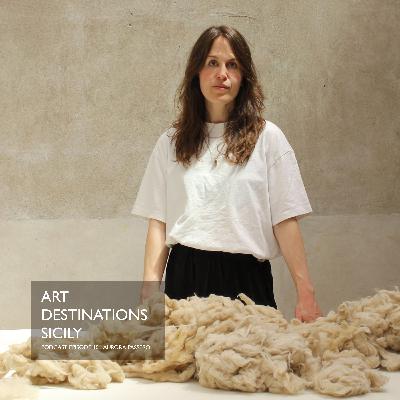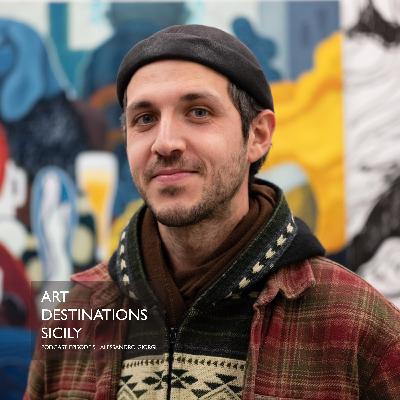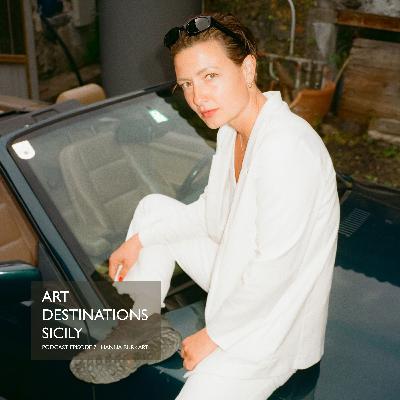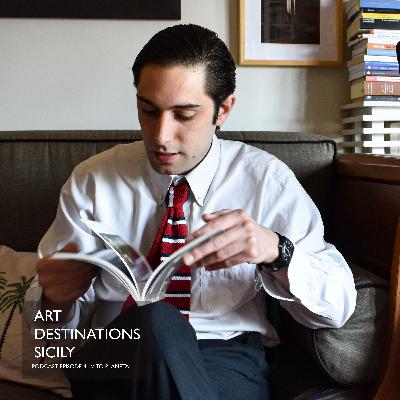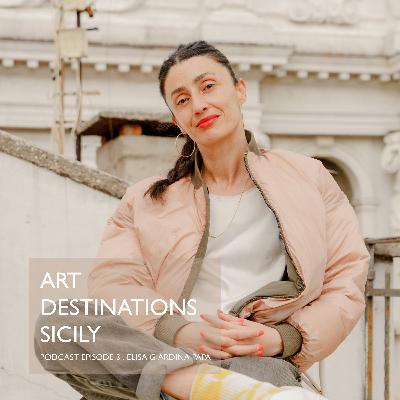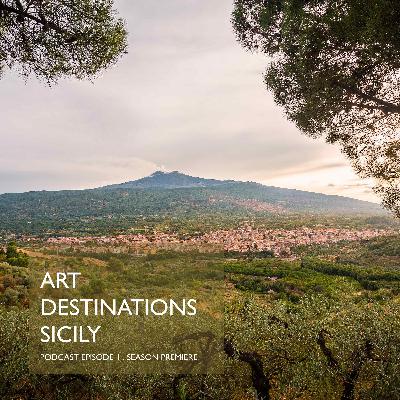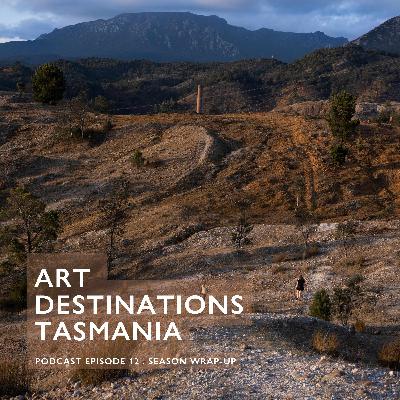Discover Art Destinations
Art Destinations

Art Destinations
Author: Sarah Rhodes and Sicily Art Residency Program (SARP)
Subscribed: 10Played: 68Subscribe
Share
© Copyright 2024 All rights reserved.
Description
Art Destinations is a podcast exploring art, place and belonging. Season 1 will begin in Venice where we interview artists and curators living and/or working in the Venetian lagoon. Season 2 and season 3 will then travel to Lutruwita | Tasmania and Sicily. We take the listener on a journey to purposefully understand a place through artists’ stories.
31 Episodes
Reverse
In this episode of Art Destination Sicily, artist Aurora Passero joins us from her Oslo studio to reflect on her creative journey. Growing up in Norway, Aurora was immersed in textiles through her grandmother’s sewing and her mother’s costume design for film. Those early tactile encounters with wool, linen, velvet, and embroidery continue to shape her work today.
Aurora shares how her father’s Sicilian roots inspired her recent residency at SARP on Mount Etna, where she balanced family life with artistic deadlines. She describes weaving with nylon and local Sicilian wool, exploring the tension between synthetic and organic materials, and creating site-specific works that engage directly with space, atmosphere, and audience.
Through stories of travelling with her artist husband and children, Aurora reveals how family, process and place intertwine in her practice.
In this conversation, we explore how staging echoes her mother’s influence and how atmosphere itself becomes a narrative in art.
Alessandro Giorgi joins Art Destinations Sicily to reflect on his childhood in a remote Sicilian fishing village Torretta Granitola which he describes as an island within an island. His childhood memories of migrant boats arriving from North Africa in the night and the unspoken presence of the Mafia have found their way into his art. Alessandro discusses his shift from architecture to art, and how drawing became both a meditative practice and a democratic tool.
Alessandro’s work flows across mediums—murals, stop-motion, and fluid drawings. His imagery responds to the rhythms of the sea, resisting borders and tracing connections across place and imagination.
Step inside Palazzo Butera in Palermo with director Claudio Gulli, where the private collection of Francesca and Massimo Valsecchi transforms the historic palace into an experimental playground for drawing links between ancient art and contemporary culture.
Palazzo Butera displays art as if in a lived-in home, inviting you to feel comfortable and make unexpected connections between historic masterpieces, contemporary works and decorative arts.
In this episode, Claudio speaks about the Valsecchi vision, Palermo’s role as a cultural crossroad, and on how a collection can be viewed as an artwork in its own right.
Vienna-born artist Hanna Burkart has spent over a decade without a permanent home, creating art through walking, sleeping and living in places across the world. In this conversation, she shares how site-specific works emerge from deep engagement in landscapes — from sleeping under the stars to transforming abandoned spaces — and how her nomadic life shapes her art.
In this episode of Art Destinations Sicily, Palermo-based artist Irene Coppola shares how her fight-specific art practice draws on walking to connect with the city's layered histories. Through observing, collecting, and moving through the streets, she reveals how Palermo’s fractured coastline continues to reflect the power of the past in shaping the present.
We discuss the legacy of WWII Allied bombings, the Mafia’s role in the Sack of Palermo, and the growing push to restore public access to the sea amid international investment and environmental clean-up efforts.
Irene also reflects on Mammelloni her poetic documentary co-directed with Ruben Monteiro, and spaziomateria, the art space she co-founded with architect Vito Priolo.
Her work speaks to how artists can uncover the hidden stories of a city—and join the fight for a more just and liveable urban future.
In this episode, we speak with Vito Planeta, who is shaping the cultural direction of Planeta Wineries by building on the vision of his late uncle, the winemaker and cultural advocate Vito Planeta (1966–2023). Together, they shared a belief in the connection between land, wine and contemporary art.
We discuss how the family’s estates across Sicily have become active sites for cultural engagement through the Culture for the Territory program, which commissions visual art, performance, music and literature. From a lakeside library dedicated to the late Vito to artworks embedded across five vineyard sites, Planeta Wineries is reframing the role of wine production in the cultural life of the island.
The conversation also explores the challenges of sustainability, the responsibilities of legacy, and how art can shift perceptions of Sicily from periphery to cultural centre.
We are in conversation with Sicilian artist and scholar Elisa Giardina Papa whose practice explores subjects that resist definition.
Elisa lives and works between New York and Sant’Ignazio, Sicily, and teaches Modern Culture and Media at Brown University. She was one of the artists invited by curator Cecilia Alemani to exhibit in the main international exhibition of the 59th Venice Art Biennale in 2022, The Milk of Dreams.
Our conversation delves into the first two works in her trilogy set in Sicily—installations that blend myth, memory, and submerged histories, both literal and metaphorical.
In She Flickered In and Out of History, Elisa explores the story of a short-lived volcanic island that emerged between Tunisia and Sicily in 1831. Claimed by various European powers before disappearing beneath the sea just five months later, the island becomes a symbol of ungovernability and resistance to imperialism.
We also discuss U Scantu: A Disorderly Tale, presented at the Venice Biennale 2022, which reimagines the mythic figure of the Donna di Fora—queer, multispecies women healers—drawing on both oral folklore and Inquisition archives. Set against the backdrop of the postmodern town of Gibellina, the work brings together sonic street culture, ceramics, and archival fragments to challenge how histories are told.
Elisa reflects on her Sicilian upbringing, the layered cultural influences of the island, and her interest in forms of knowledge that defy categorisation. Together we explore what it means to live, think, and create on the edges — where ground shifts, language carries memory and stories flicker in and out of view.
Alfio Puglisi in conversation with podcast host Sarah Rhodes on how the Sicily Artist in Residence Program (SARP) is transforming Sicily into a global hub for contemporary art through site-specific residencies, local collaboration, and atmospheric place-making.
In this wide-ranging conversation, Sarah Rhodes speaks with the podcast’s co-producer Alfio Puglisi — founder of the Sicily Artist in Residence Program (SARP) — about returning to his ancestral home on the slopes of Mount Etna to forge a new vision for contemporary art in Sicily. Alfio shares his remarkable journey: from studying economics and the digital economy and society at King’s College London to teaching in Lisbon, and ultimately leaving behind a secure academic career to pursue something more entrepreneurial and creatively rooted. That shift led him back to Linguaglossa, where he transformed his family’s 17th-century palazzo into a living museum, restaurant, contemporary gallery and residency program.
Through SARP, Alfio brings together international and local artists, offering them space, support, and time to develop site-responsive work. The program emphasises collaboration with local artisans, curators, and Sicilian production facilities, ensuring that exhibitions are deeply embedded in place. These are not parachute residencies, but long-form engagements that invite artists to slow down, adapt, and attune to Sicily’s layered histories and landscapes.
Together, they discuss:
The personal and political significance of returning home to begin again
Why Sicily’s “peripheral” location may actually be a place of focus and clarity for artists
The interplay between cultural memory, atmospheric conditions, and contemporary creative practice
The red Saharan rain that settles each spring on Sicilian gardens — and how this meteorological phenomenon became the digital pigment for new photographic work by Andre Hemer
How Alfio’s vision for SARP builds on both inherited history and future-facing cultural networks
The growing community of creatives — many returning from cities like London, Paris, and Berlin — who are reshaping Sicily’s role in the international art conversation
This episode offers a meditation on place, return and reinvention. As Alfio says, Sicily’s position at the centre of the Mediterranean offers not just geography, but perspective — a place to think, to feel, and to make without distraction.
Listen in as we reflect on the links between atmosphere and art-making, the value of community and continuity, and how peripheral places can become sites of deep cultural transformation.
In this premiere episode of Art Destinations Sicily, we introduce the artists and key themes that will be explored in season. We look at how artists engage with the layered geographies of Sicily — a place shaped by ancient myths, volcanic terrain, and a complex cultural inheritance. Through residencies and site-responsive projects, the artists featured in this season reveal how creative practice emerges from deep entanglements with land, memory, and material.
Our conversations begin with this podcast’s co-producer and Sicily Artist-in Residence Program (SARP) director Alfio Puglisi. And then we have the privilege of meeting Elisa Giardina Papa (Italy’s Venice Biennale 2022 artist), Vito Planeta (Planeta Wines), Irene Coppola (artist and Spaziomateria, Palermo), Francesco Vullo (artist), Claudio Gulli (art historian, Palazzo Butero, Palermo), Hanna Burkart (artist), Aurora Passero (artist) and Alessandro Giorgi (artist).
The key ideas are:
Collaborating with Place
The Sicilian landscape—particularly Mount Etna—acts not merely as a backdrop but as an active force shaping artistic practice. Across episodes, artists respond to the island’s geology, climate, and topography as both medium and subject.
Reimagining Cultural Identity
Artists explore Sicily’s layered histories, myths, and social taboos to question and reframe local identity. Folklore, symbolism, and personal narratives are reinterpreted through contemporary lenses to address belonging, memory, and transformation.
3. A Return to Materiality
There is a strong return to material practices—textiles, volcanic rock, pigment, and site-specific installation—as a way to connect past and present. This material sensibility serves as a tactile bridge between tradition and experimentation.
4. Peripheral Networks and Global Dialogue
Sicily’s perceived peripherality fosters a fertile ground for international collaboration. Through residencies and projects like SARP, artists from diverse backgrounds engage with the island to generate new models of exchange, intimacy, and creative dwelling.
The Sicily season reveals that working from the edge — whether spatially or culturally — creates rich opportunities to rethink place, practice, and belonging. Artists in this season treat the island not only as a site, but as a way of being.
We hope you enjoy this season of Art Destinations Sicily.
Each episode is released fortnightly. Subscribe to our newsletter, follow us on your preferred listening platform. such as Apple Podcasts or Spotify, and explore the visual works of our guests via @artdestinations.podcast on Instagram.
We reflect on the Art Destinations Lutruwita | Tasmania season in a wrap-up episode that draws links between the 10 artists and writers in conversationacross the episodes. We also draw parallels between season 1 Venice and season 2 Lutruwita | Tasmania.
World leading philosopher on place Jeff Malpas lays the foundation for the Lutruwita | Tasmania season as his conversation frames the role of place in thinking. We examine how artists’ practices are shaped by cultural memory and the natural environment.
In this episode we cover: :
examine art as activism from the perspectives of Matthew Newton, David Stephenson and Raymond Arnold,
the role of isolation in forming a connection with nature, building community and finding resonances interationally as shared through the work of Troy Ruffels, Zoe Grey and Ellen Dahl,
imagination and place through Pat Brassington’s surreal works explore feminist themes while reflecting an imagined sense of place,
stories that give access to isolated worlds through Adam Thompson’s short stories based on his Indigenous culture and Lisa Garland’s stories behind the portraits of her North-West Coast community, and
we draw parallels between the Venice and Lutruwita | Tasmania seasons. In Venice, artists embrace marginality as a strength, collaborating on smaller islands in the lagoon to reimagine shared spaces. In Tasmania, geographical isolation inspires self-reflection and deep connection with the natural world.
In summary, being on the edge—geographically, culturally, or conceptually—offers unique opportunities for reflection, innovation, and meaningful engagement with place and environment. We explore how art thrives in these peripheral spaces.
We are in conversation with US-born photographic artist David Stephenson, who received an MFA from the University of New Mexico in 1982 before taking a teaching position at the University of Tasmania’s School of Art. His work has consistently explored the sublime, in relation to his transcendental experience of place.
With an ongoing interest in human interventions in the landscape, David arrived in Tasmania in the lead-up to the Franklin Dam blockade and continues to document Tasmania’s contested places. He also experiments with the different ways the photographic image, and different subject matters, can represent time.
His work is in many permanent collections including the National Gallery of Australia, the National Gallery of Victoria, the Art Gallery of New South Wales, the Museum of Contemporary Art Australia, the San Francisco Museum of Modern Art, and both the Museum of Modern Art and the Metropolitan Museum of Art in New York.
David Stephenson is represented by Bett Gallery, Hobart, Jackson Fine Art, Atlanta and Boutwell Schabrowsky, Munich.
You can see David’s work on our instagram page @artdestinations.podcast
This is the second part of our two-part conversation with Raymond Arnold. Raymond talks about his printmaking and painting practice, and how he shares his art practice with his community in Queenstown with the aim of revitalising the region.
In part one, Raymond gave us some background on why Lutruwita | Tasmania is such an important landscape and how it became an environmental batttleground.
For the listeners who have never been to Queenstown, it is an extremely isolated town on Lutruwita's west coast, surrounded by forest and mountain ranges. It is now a landscape healing after bearing scars from an energetic copper extraction and smelter operation starting at the turn of the 20th Century; which left the surrounding mountains bare and the rivers polluted.
In the late 1990s Raymond left teaching at the Tasmanian School of Art, and moved to Queenstown with his partner Helena Demczuk. Since then they have focused on their art practises and use art to revitalise the town.
We are in conversation with the wonderful painter and printmaker Raymond Arnold, who has lived in Queenstown, on Lutruwita | Tasmania’s West Coast since the late 1990s with his wife Helena, Demczuk and their four whippets.
The conversation naturally shaped itself into two main themes: environmental activism and his art practice, so we have divided his podcast into two 35-minute parts.
In part one, Raymond explains his involvement in the Franklin Dam blockade. He had just taken a teaching position at the Tasmanian School of Art when he was invited to join the busload of artists travelling to protest against the damming of one of Tasmania’s last wild rivers. They were all among the 1300 arrested.
This formative experience contributed to Raymond’s intimate understanding of Tasmania as a social, political and environmental battleground.
We are in conversation with Lisa Garland, a photographic artist who has been documenting her community on the North-West Coast for more than 20 years. Lisa makes portraits of people so deeply connected to where they live that often the portrait of their place tells more about them than the people themselves. As a new generation is emerging and another passing, Lisa reflects on what she looks for in her subjects and how her focus is changing.
In this episode we cover:
how Lisa’s photographic portraits of people and places are influenced by her upbringing and community,
how Lisa’s early career as a newspaper photographer made her value her own personal projects, particularly portraits of her family and community members,
documenting generational changes occuring in Lutruwita | Tasmania, particularly during residencies in Queenstown and King Island,
how the intimate relationship between artist and subject comes through in her images and the extent the stories shared are conveyed through image and text,
the changes in Tasmania's cultural and physical landscapes and the loss of traditional craftsmanship,
her shift from portraiture to photographing symbolic spaces, and
the value of storytelling and the significance of preserving the authenticity of her subjects and their environments.
We are in conversation with Pat Brassington, one of Australia’s most significant and influential artists. Over four decades, Brassington has captivated audiences with her ability to transform the familiar into the fantastical through her enigmatic photomontages.
This conversation is recorded as a radio play where a voice artist performs Brassington’s responses to my questions.
In this episode we cover:
how Brassington’s childhood in Hobart has influenced her practice. At a young age, Brassington contracted polio. She was confined to her bedroom for six weeks and experienced a heightened feeling of isolation. This experience, in combination with catching tadpoles with her brother and playing in suburban backyards, sparked her artistic imagination.
how Tasmania and the concept of isolation influenced her artistic imagination,
Brassington’s exploration of contradictions, inspired by dialectics, surrealism and psychoanalysis,
her use of distortion, symbolism, and the provocative use of pink, and
insights into her lens-based practice, blending straight photography with manipulated images to evoke unsettling yet captivating emotions.
Adam Thompson, a Pakana writer, sources much of the inspiration for his stories from his experiences working across the archipelago of Furneaux islands between lutruwita | Tasmania and mainland Australia. These islands are not only the backdrop for his dark moral tales but they also hold his family history.
We talk about his work as a builder and ranger on Badger, Mount Chappell and Big Dog islands that inspired his collection of short stories Born Into This, as well as the TV series Moonbird to be screened on the SBS channel NITV in 2025.
Adam shares his writing process and how he sees his role as a father imparting his cultural knowledge to his son.
I acknowledge, with deep respect, the traditional owners of Lutruwita (Tasmania) Aboriginal land, sea and waterways. For many years the Palawa people referred to this land as Palanwina Lurini Kanamaluka meaning ‘the town near river Tamar’. I respectfully acknowledge their Ancestors and Elders, past and present. Always was, always will be, Aboriginal land.
Ellen Dahl is a visual artist who grew up in the Arctic North of Norway and is now living and working on Gadigal Country in Sydney. Her expanded photographic practice questions whether the landscapes in lutruwita | Tasmania, and Svalbard, north of the Arctic Circle share something in common. Do these two places on the peripheries offer another way of understanding how we see and feel about the world?
Our conversation follows her winning the National Photography Prize 2024 with MAMA Albury, showing at the contemporary photography art fair Unseen Amsterdam and her current Oct/Nov 2024 show with Melbourne gallery, This is No Fantasy.
We are in conversation with Troy Ruffels, a photomedia artist drawing on the tradition of painting and drawing, to make works that are both immersive and atmospheric. Troy incorporates the elements of fire and water into his daily routine from pre-dawn ocean swims to evening fire pits, creating a discipline for his art practice.
As a country boy growing up in Forth on Tasmania’s north-west coast, Troy’s career was launched at the Museum of Contemporary Art’s Primavera exhibition for emerging artists in 1997. Since then he has continued his exploration of boundaries: through the mediums he uses or the poetic language to evoke the atmosphere of weather. Troy lectures at the University of Tasmania’s School of Creative Art, Inveresk and is represented by Bett Gallery in Hobart.
You can see Troy’s work on our Instagram page @artdestinations.podcast.
Troy would like to take a moment to correct an error he made during a recent conversation for Art Destinations. While discussing key individuals involved in the Digital Art Research Facility, he mistakenly referred to Mary Knights. The correct name is Mary Scott who was key participant in this research project. Troy is sorry for the oversight. Mary Scott was an invaluable part of this project, and he would like to ensure their contribution is fully recognised. He sincerely apologises for any confusion caused and appreciate your understanding.
Matthew Newton, an accomplished photojournalist and cinematographer, has spent 25 years capturing Tasmania's rich environmental landscapes. Matt discusses his unique career path, starting as a whitewater kayaker before delving into photography and filmmaking. He shares insights into his collaborative projects, including documenting Tasmania's wilderness and history, and how his work with writers, artists and conservationists has brought stories of the natural world to life.
We also explore major projects working with the Tasmanian Land Conservancy and some of the nation's leading artists on arts project The Skullbone Plains Experiment and with scientists on Albatross Island, highlighting how visual storytelling and partnerships have raised awareness about Tasmania’s hidden wonders.
Through his unique experiences, Matt reveals the transformative power of film and photography in promoting environmental conservation and bridging connections between people and places.
We are thinking about thinking with one of the world leading philosophers on place Jeff Malpas in Hobart. We question where and how one can do their best thinking, the roles of centre and periphery in the evolution of ideas, how the zeitgeist actually works, and the highly influential role our childhood has on how we think as adults.


